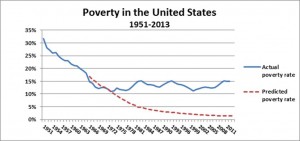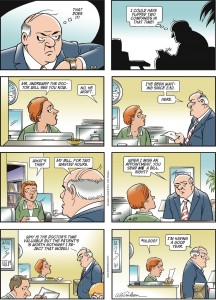Why We Lost the War on Poverty
Take a look at the graph below. From the end of World War II until 1964 the poverty rate in this country was cut in half. Further, 94% of the change in the poverty rate over this period can be explained by changes in per capita income alone. Economic growth is clearly the most effective antipoverty weapon ever devised by men.
The dotted line shows what would have happened had this trend continued. Economic growth would have reduced the poverty rate to a mere 1.4% of the population today ― a number so low that private charity could probably have taken care of any unmet needs.
But we didn’t continue the trend. In 1965 we launched a War on Poverty. And as the graph shows, in the years that followed the portion of Americans living in poverty barely budged. In 1965, 18% of the population lived in poverty. Today we are at 15%, or 50 million Americans. That’s after spending $15 trillion on antipoverty programs and continuing to spend $1 trillion a year.







